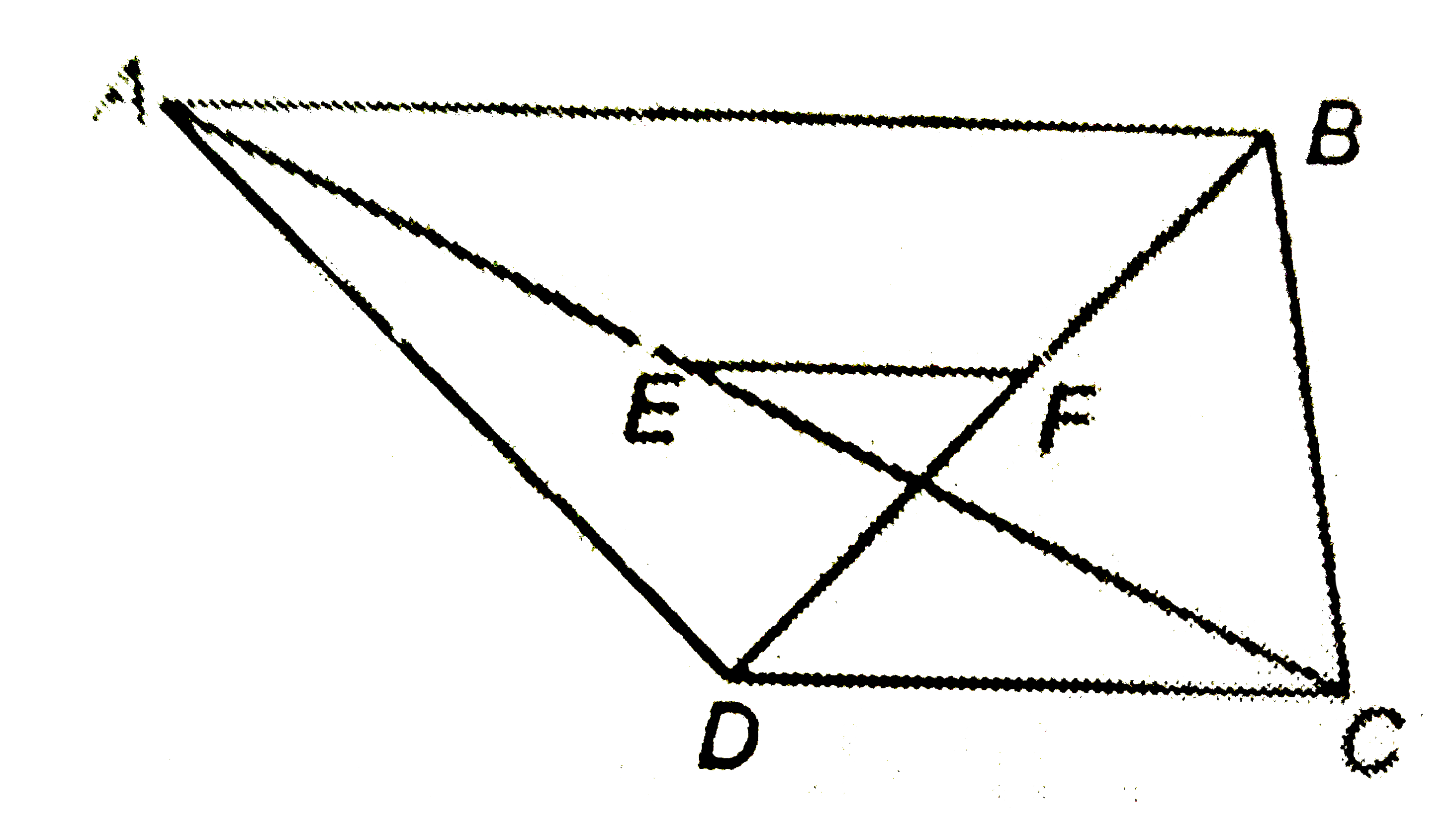ABCD is a quadrilateral. P (3,7) and Q (7, 3) are the middle points of the diagonals AC and BD respectively. The coordinates of the mean point (or the centre of mean position) of the vertices of the quadrilateral are
(0, 0)
(3, 3)
(5, 5)
(7, 7)
The correct Answer is:C
To find the coordinates of the mean point (or the center of mean position) of the vertices of the quadrilateral ABCD, we can follow these steps:
Step 1: Identify the midpoints of the diagonals
We are given that P (3, 7) is the midpoint of diagonal AC and Q (7, 3) is the midpoint of diagonal BD.
Step 2: Calculate the midpoint of the segment joining P and Q
The mean point of the vertices of the quadrilateral can be found by calculating the midpoint of the line segment joining points P and Q.
The formula for the midpoint M(x, y) of two points A(x1, y1) and B(x2, y2) is given by:
M=(x1+x22,y1+y22)
Step 3: Substitute the coordinates of P and Q into the midpoint formula
Substituting the coordinates of P (3, 7) and Q (7, 3):
M=(3+72,7+32)
Step 4: Simplify the calculations
Calculating the x-coordinate:
3+72=102=5
Calculating the y-coordinate:
7+32=102=5
Step 5: Write the final coordinates of the mean point
Thus, the coordinates of the mean point (or center of mean position) of the vertices of the quadrilateral ABCD are:
(5,5)
Final Answer:
The coordinates of the mean point of the vertices of the quadrilateral ABCD are (5, 5).
---
We are given that P (3, 7) is the midpoint of diagonal AC and Q (7, 3) is the midpoint of diagonal BD.
The mean point of the vertices of the quadrilateral can be found by calculating the midpoint of the line segment joining points P and Q.
M=(x1+x22,y1+y22)
Substituting the coordinates of P (3, 7) and Q (7, 3):
M=(3+72,7+32)
Calculating the x-coordinate:
3+72=102=5
7+32=102=5
Thus, the coordinates of the mean point (or center of mean position) of the vertices of the quadrilateral ABCD are:
(5,5)
The coordinates of the mean point of the vertices of the quadrilateral ABCD are (5, 5).
Topper's Solved these Questions
- BOOK - MCGROW HILL PUBLICATIONCHAPTER - CARTESIAN SYSTEM OF RECTANGULAR COORDINATES AND STRAIGHT LINES EXERCISE - EXERCISE (LEVEL 2) SINGLE CORRECT ANSWER TYPE QUESTIONS21videos
CARTESIAN SYSTEM OF RECTANGULAR COORDINATES AND STRAIGHT LINES
- BOOK - MCGROW HILL PUBLICATIONCHAPTER - CARTESIAN SYSTEM OF RECTANGULAR COORDINATES AND STRAIGHT LINES EXERCISE - EXERCISE (NUMERICAL ANSWER TYPE QUESTIONS)21videos
CARTESIAN SYSTEM OF RECTANGULAR COORDINATES AND STRAIGHT LINES
- BOOK - MCGROW HILL PUBLICATIONCHAPTER - CARTESIAN SYSTEM OF RECTANGULAR COORDINATES AND STRAIGHT LINES EXERCISE - EXERCISE (CONCEPT - BASED) SINGLE CORRECT ANSWER TYPE QUESTIONS15videos
CARTESIAN SYSTEM OF RECTANGULAR COORDINATES AND STRAIGHT LINES
- BOOK - MCGROW HILL PUBLICATIONCHAPTER - AREA BY INTEGRATIONEXERCISE - Question from Previous Years. B-Architecture Entrance Examination Papers12videos
AREA BY INTEGRATION
- BOOK - MCGROW HILL PUBLICATIONCHAPTER - CIRCLES AND SYSTEMS OF CIRCLES EXERCISE - QUESTIONS FROM PREVIOUS YEARS. B-ARCHITECTURE ENTRANCE EXAMINATION PAPERS17videos
CIRCLES AND SYSTEMS OF CIRCLES
Similar Questions
Knowledge Check
- Question 1 - Select One
M and N are the mid-points of the diagonals AC and BD respectively of quadrilateral ABCD, then AB+AD+CB+CD is equal to
A2 MNB2NMC4 MND4 NM - Question 2 - Select One
ABCD is a parallelogram. P and Q are mid points of BC & CD. Find the area of ΔAPQ if area of ΔABC is 12.
AtrapeziumBparallelogramCsquareDnone of these - Question 3 - Select One
In a quadrilateral ABCD, with unequal sides if the diagonals AC and BD intersect at right angles, then
AAB2+BC2=CD2+DA2BAB2+CD2=BC2+DA2CAB2+AD2=BC2+CD2DAB2+BC2=2(CD2+DA2)
If PQ are the mid points of diagonal AC and BD respectively of a quadrilateral ABCD, then prove that −−→AB+−−→AD+−−→CB+−−→CD = 4 −−→PQ
View SolutionIn a quadrilateral ABCD, with unequal sides if the diagonals AC and BD intersect at right angles, then
View SolutionABCD is a quadrilateral. AM and CN are perpendiculars to BD, AM= CN and diagonals AC and BD intersect at O, then which one of the following is correct?
View SolutionM and N are mid-point of the diagnols AC and BD respectivley of quadrilateral ABCD, then¯¯¯¯¯¯AB+¯¯¯¯¯¯AD+¯¯¯¯¯¯CB+¯¯¯¯¯¯CD=
View SolutionABCD is a parallelogram, P and Q are the points on the diagonal AC such that AP=QC, then quadrilateral BPDQ is a :
View Solution


